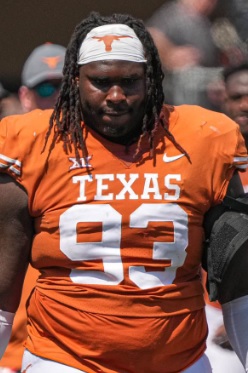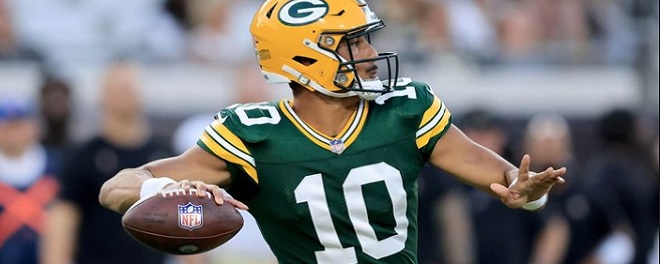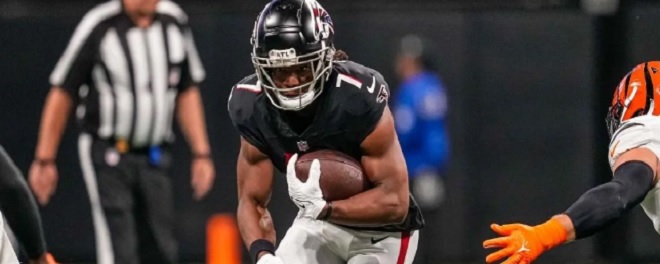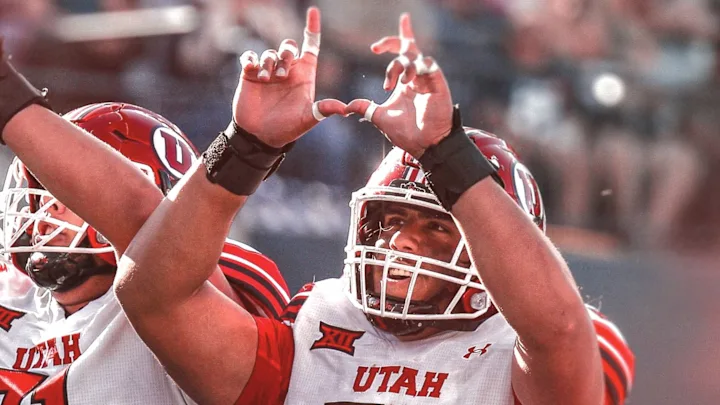Defensive Tackle Class
Early-round talent: B+Mid-round: B
Late-round: B-
Overall grade: B
Merging the 2023 and 2024 prospects
Jalen CarterByron Murphy II
Calijah Kancey
Kris Jenkins
Johnny Newton
Michael Hall Jr.
Mazi Smith
Bryan Bresee
Keeanu Benton
T’Vondre Sweat
Braden Fiske
Gervon Dexter
Zacch Pickens
Byron Young
Ruke Orhorhoro
Brandon Dorlus
Just to be clear, this article and series is all my opinion based off my own study and information I’ve gotten from general managers, directors of college scouting, national scouts, area scouts and NFL coaches. They all know way more than I do.
Last year, there were four defensive tackles selected in the first round and some decent talent on Day 2. This year is comparable in the quantity of prospects for Day 1 and 2. The 2024 NFL Draft, however, does not feature a sure-fire top-10 prospect like last year did.
If you were to merge these two classes together, Jalen Carter would be the top prospect with Byron Murphy not too far behind. Calijah Kancey was a better prospect than Kris Jenkins, Johnny Newton and Michael Hall Jr. However, those three are better than Mazi Smith and Bryan Bresee. Keeanu Benton was a better prospect than T’Vondre Sweat and Braden Fiske. Those two are better prospects than Gervon Dexter, Zacch Pickens and Byron Young were. Ruke Orhorhoro and Brandon Dorlus are third-round caliber prospects, like Young.
Safest Pick: Jalen Carter, Georgia 
Previous Picks:2023:Jalen Carter
2022:Jordan Davis
2021:Christian Barmore
2020:Derrick Brown
2019:Christian Wilkins
2018:Vita Vea
2017:Jonathan Allen
2016:Jarran Reed
2015:Leonard Williams
2014:Louis Nix
2013:Star Lotulelei
From a skill-set perspective, Murphy is a safe bet to turn into a good pro. He has serious physical talent with speed, power and athleticism. Murphy lacks height and length, but he makes up for it with his quickness at the point of attack and developed strength. It would be surprising if he didn’t turn into a solid pro starter.
Biggest Bust Potential: Brandon Dorlus, Oregon 
Previous Picks:2023:Siaki Ika
2022:Perrion Winfrey
2021:Marvin Wilson
2020:Ross Blacklock
2019:Jerry Tillery
2018:Maurice Hurst
2017:Malik McDowell
2016:Robert Nkemdiche
2015:Mario Edwards Jr.
2014:Anthony Johnson
2013:Jesse Williams
This was a difficult selection. I considered Michael Hall Jr. because of his character issues. I also considered T’Vondre Sweat because of his weight and work ethic. However, Dorlus seemed the riskiest overall. While he has some pass-rush ability, Dorlus is undersized and does not play hard 100 percent of the time. His lack of effort and bad motor are going to lead to pro coaches benching him if those habits aren’t changed immediately. Thus, I think Dorlus has the most bust potential of the early-round tackles.
Defensive Tackle Rankings by Attributes
Pass Rush:
NFL prototype: Aaron Donald, Retired
- Byron Murphy II
- Braden Fiske
- Johnny Newton
- Darius Robinson
- Michael Hall Jr.
- Ruke Orhorhoro
- Kris Jenkins
- T’Vondre Sweat
Recap: The NFL is always searching for interior linemen who can get after the quarterback. They are a hard commodity to find, and one can make a massive impact on a team’s ability to rush the passer. Tackles who can rush the quarterback set up a lot of sacks for edge rushers via disruption and double-teams. The fastest way to get to a quarterback is from up the middle, and even just forcing quarterbacks to get off their drop spot hurts the passing game. Pass rush up the middle is more disruptive for quarterbacks than edge rushing.
Murphy is very dangerous in the pass rush. He is a quick defender at the point of attack with the ability to fire his gap to get penetration upfield. Behind natural pad level, Murphy does a phenomenal job of fighting through guards and making it difficult for them to sustain blocks. While Murphy lacks some size, he is built strong in the upper and lower body. That allows him to drive block and bull rush through offensive linemen. Murphy uses heavy hands to jolt offensive linemen with the power and then knocks them aside via an impressive club move. Murphy closes on the quarterback in a hurry and shows good vision, instincts, and awareness to adjust to a moving signal-caller. Thanks to his natural and functional strength, Murphy can push through blocks and can close in an instant on the quarterback. Murphy possesses an impressive set of pass-rushing moves plus can with sheer power and speed.
What sets Fiske apart and makes him an intriguing player for the NFL is his interior pass-rush ability. Using a burst off the snap, Fiske can fire upfield to get penetration into the pocket, and his relentless motor helps him to finish rushes by outfighting blockers to get to the quarterback. Fiske uses active hands to keep guards from getting a hold of him, and his natural pad level keeps him low with good leverage. Thanks to good athleticism and agility, Fiske can contort his body to dip underneath blockers and keep gaining on the quarterback. Fiske’s speed and athleticism to contribute in the pass rush are his standout aspects to get drafted early and play a key role in the passing-driven NFL.
As a pass rusher, Newton is impressive. He is athletic and twitchy at the point of attack plus has a burst to fire his gap. With developed strength and active hands, Newton will slap defenders off of him and use his speed to dart past blockers. Newton shows a real burst to close, and there is no doubt that he is a fast interior rusher. Newton possesses fluid hips to slide away from blockers and dart into openings to get after the quarterback. While Newton has a stocky build, he runs really fast for a big man. Newton has the potential to be an excellent NFL interior pass rusher who produces some quality sack numbers while contributing a number of hits, pressures and hurries that could help set up his edge rushers to notch sacks as well.
Robinson is a talented pass rusher capable of making a difference for his defense. He has a dangerous power rush with a strong upper body and a serious ability to grab offensive tackles and toss them to the side. His ability to shed blocks is phenomenal and very developed for a player entering the NFL. Thanks to the power in his upper and lower body, Robinson can bull rush offensive tackles into the pocket or knock them balance to get them out of position. Robinson has the size and strength to slide inside in the sub package. While Robinson is big and strong, he lacks juice and explosion off the ball. His lack of speed rush off the edge is his biggest weakness.
Hall is quick off the ball as a pass rusher, plus is a capable three-technique to line up over the outside shoulder of the guard. Hall uses his quick first-step to fire his gap and achieve penetration upfield. Aided by his burst to fire into the backfield, Hall has real ability to create disruption in the backfield while denying a quarterback the ability to step up in the pocket. Hall also has some athleticism to redirect and adjust to a scrambling signal-caller. Hall is not stiff and has loose hips to change direction. While Hall is quick, he also has some upper strength to slap hands away while working to upfield to get after the quarterback.
In the pass rush, Orhorhoro does a nice job of getting on angles of guards to get penetration upfield. He has a burst off the ball and quickness to close when he gets free. While Orhorhoro possesses a thick build, he is not stiff and has some hip movement to not be a straight-line player. Orhorhoro has some power to his bull rush and can generate a push to get his offensive linemen retreating backward into the pocket. For the NFL, Orhorhoro needs to develop more pass-rushing moves.
Jenkins has upside to improve as a pass rusher. Michigan’s scheme did not always let him pin his ears back and go after the quarterback, but when he was given the green light, Jenkins did a nice job of pressuring the signal-caller. Jenkins has quickness to fire the gap and athleticism with loose hips to dodge blockers or loop around. When Jenkins gets free, he shows a burst to close and will violently put the quarterback into the turf. Jenkins is dangerous on games, doing a very good job of executing stunts. As a pro, it would help Jenkins to add refine and diversify his pass-rushing moves. After some development, Jenkins could be a three-down starter in the NFL. He may never be a prolific pass rusher who puts up double-digit sacks, but he has the potential to be a player who produces 6-8 sacks per season in the better years of his career.
As a pass rusher, Sweat has some ability to get a push into the backfield with his power, but after gaining some ground upfield, Sweat struggles to finish the play by getting to the quarterback. Sweat is limited from both a speed perspective and an athleticism perspective to be a dangerous pass rusher in the NFL. However, Sweat shows nice awareness to get his hands up and block passes. As a pro, he probably will be rotated out of the game in many sub packages, but he can help contribute to a rush by clogging the middle to limit space for a quarterback to step up.
Run Defense:
NFL prototype: Javon Hargrave, 49ers
- Kris Jenkins
- Byron Murphy II
- T’Vondre Sweat
- Ruke Orhorhoro
- Michael Hall Jr.
- Darius Robinson
- Johnny Newton
- Braden Fiske
Recap: In the ground game, Jenkins is a dynamic defender with instincts that lead him to make tackles and cause disruption. Over the past two seasons, Jenkins was one of college football’s best run-defending linemen. He is extremely stout at the point of attack. When runs come downhill at him, he is able to anchor and hold his ground. He also shows the strength to shed and tackle. Jenkins can push his way into the backfield to disrupt runs and reset the line of scrimmage. His lateral anchor was advanced for a college player, making him tough to move at the point of attack even when facing double teams. Jenkins is very strong at taking on double-team bump blocks and holding his ground when getting hit from the side. Entering the NFL, Jenkins is a very good run defender. He has the potential to be a huge asset as a run defender in the pros.
Murphy is a solid run defender. He has a strong, thick lower body that lets him hold his ground at the line of scrimmage. He fills his gap and can be tough to move. Murphy is able to eat up his block, prevent holes from opening up, and maintain gap integrity. Murphy plays hard and gives a second effort if he’s initially blocked. He also will attempt to make tackles in the ground game downfield thanks to his steady motor.
Sweat is a tough run defender and is very stout at the point of attack. When the rush comes downhill at him, he is able to anchor and hold his ground. Sweat also shows the strength to shed and tackle. He can push his way into the backfield to disrupt runs and reset the line of scrimmage. His lateral anchor was advanced for a college player, making him tough to move at the point of attack. Sweat is very strong, helping him take on double-team bump blocks and hold his ground despite getting hit from the side. Sweat is a very good run defender entering the NFL, and as a pro, he will be an asset to defend short-yardage and goal-line situations.
In the ground game, Orhorhoro has the size and strength to hold his spot against downhill runs coming straight at him. He also can disrupt and make plays behind the line of scrimmage. Orhorhoro will use his quickness to shoot his gap and create havoc in the backfield. He did not always play up to his skill set in 2023. He should have generated more tackles as a run defender.
As a run defender, Hall is at his best firing his gap and trying to cause disruption in the backfield. In the college game, he held up well as a nose tackle despite being undersized. However given his weight, he could have issues with mass and defending downhill runs coming straight at him at the next level.
Against the rush, Robinson is very good when lining up at defensive end. He uses his strong build and length to set a tough edge at the point of attack. Robinson can hold his ground in run defense, maintaining his gap and not getting pushed back. With heavy hands, Robinson has the power and good hands to fight off blocks to get in on tackles of ball-carriers. However if the lines up inside at tackle, he could have problems with the power and mass of NFL guards.
Newton looked better in the ground game in 2022 than he did in 2023. Over his final season, he was worse against the run, but in both years, there were times where he was absolutely destroyed by offensive linemen. There were plays where Newton was blown out of his gap and pushed around the field.
Fiske is a liability in run defense entering the next level, according to team sources. He lacks the length, height and weight to stand up blockers and keep them from getting a push. Fiske can get knocked off the ball, and power guards in the NFL are going to pose a problem for pushing him out of his gap. He is going to have real issues defending downhill runs coming straight at him, and his lateral anchor needs to get much better. Bump blocks are going to be a problem for Fiske. He needs to do a lot of work on his run defense for the NFL.
Speed:
NFL prototype: Aaron Donald, Retired
- Braden Fiske
- Byron Murphy II
- Michael Hall Jr.
- Johnny Newton
- Kris Jenkins
- Ruke Orhorhoro
- Darius Robinson
- T’Vondre Sweat
Recap: Fiske is the fastest with his explosion off the snap and ability to fire into the backfield. Murphy and Hall are fast interior defenders and are explosive. Newton and Jenkins have a disruptive burst off the ball. Orhororo, Robinson and Sweat are quick on the inside. Robinson lacks speed and explosion for a defensive end.
Three-Technique:
NFL prototype: Chris Jones, Chiefs
- Byron Murphy II
- Johnny Newton
- Michael Hall Jr.
- Braden Fiske
- Kris Jenkins
- Darius Robinson
- Ruke Orhorhoro
- T’Vondre Sweat
Recap: Good three-techniques can be hard to find, and this class has a few players who could do some work in that role.
Murphy’s speed, burst off the ball, and strength to power through blockers could make him a beast as a three-technique. Newton and Hall are both quick at the point of attack and have the ability to fire their gap to cause disruption. Each is a good fit for three-technique in the NFL.
Fiske is a phenomenal fit for three-technique because he is fast, possessing pure explosion off the ball. He can fire his gap and get into the backfield in a blur. However, Fiske needs to add weight to hold up and handle a quality work load.
Jenkins flashed some three-technique potential at Michigan, but the program’s scheme did not allow him to consistently go upfield. He was often called on to hold his ground at the line and keep his gap locked down. Jenkins has quickness and athleticism, so he could be a three-technique as a pro.
Robinson could play three-technique in the NFL, as he has enough ability to get the job done. Orhorhoro also has the physical talent to play three-technique. Sweat does not fit as a three-technique. Instead, he is a heavy nose tackle for the NFL.
3-4 Defensive End:
NFL prototype: Jeffery Simmons, Titans
- Darius Robinson
- Kris Jenkins
- Ruke Orhorhoro
- T’Vondre Sweat
- Byron Murphy II
- Michael Hall Jr.
- Johnny Newton
- Braden Fiske
Recap: This group has some natural fits for 3-4 defensive end. Robinson could be an excellent 3-4 defensive end who also offers pass-rush ability for a five-technique. Jenkins and Orhorhoro could be good fits as five-technique defensive ends. Sweat is a nose tackle, but he has enough length and height to play five-technique as well. Murphy could play five-technique, but Hall, Newton and Fiske are not good fits for the role.
Nose Tackle:
NFL prototype: Vita Vea, Buccaneers
- T’Vondre Sweat
- Kris Jenkins
- Ruke Orhorhoro
- Byron Murphy II
- Johnny Newton
- Darius Robinson
- Michael Hall Jr.
- Braden Fiske
Recap: A good nose tackle in a 3-4 defense is a tough commodity to find. Someone like Vince Wilfork or Casey Hampton in their prime sets the tone for the pass rush and the run defense by blasting the center into the backfield. An effective zero-technique stuffs the run and occupies interior blockers to open up lanes for blitzes up the middle.
Sweat, Jenkins and Orhorhoro are well-suited to play nose tackle. They have the strength, length, and burst to be tough to move out of their gap. Murphy is not a great fit to play nose tackle, but he could get the job done with his strength. Newton, Robinson, Hall and Fiske are not fits to play nose tackle.
NFL Picks - Dec. 25
2026 NFL Mock Draft - Dec. 24
NFL Power Rankings - Dec. 23
Fantasy Football Rankings - Sept. 1





